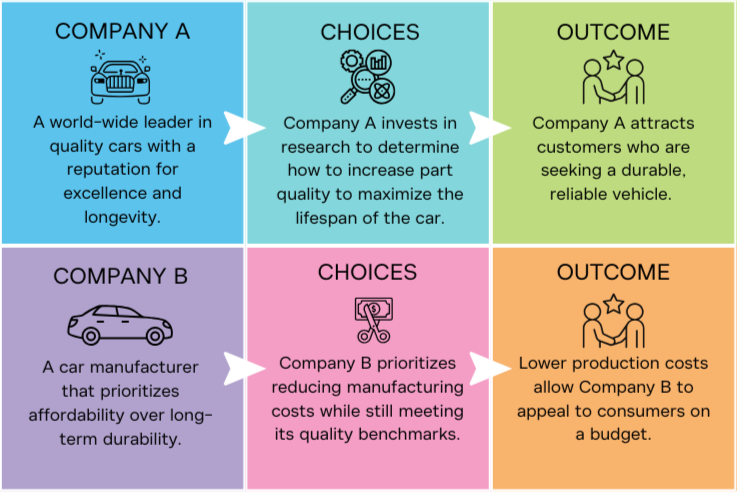When you think about the cars we see on the roads every day, it’s easy to overlook the underlying choices that define their design, quality, and price. Yet, every vehicle is the outcome of countless strategic decisions made by its manufacturer. Some companies prioritize quality and longevity, while others emphasize affordability and accessibility. These choices don’t just shape the vehicles we drive—they also determine how companies position themselves in the automotive market.
This blog will explore the ways in which strategic choices drive differentiation, using two well-known car companies as examples. To focus on the strategies rather than the brands, we’ll call them Company A and Company B. By examining their distinct approaches to quality and cost, we’ll uncover how these decisions reinforce their respective market positions.
A Tale of Two Strategies
Company A is known worldwide as a leader in quality cars. Consistently at the top of most quality charts for many years, they have built a reputation for excellence and longevity. In contrast, Company B is often listed in the bottom third of quality surveys. However, this comparison is not about determining which company is better. Instead, it’s about understanding how their strategic choices lead to different outcomes.
The Power of Choices: A Practical Example
One way to illustrate these differing strategies is through the tear-down process. It is common for car manufacturers to completely disassemble vehicles to inspect parts for wear and tear. The insights gained from this process inform decisions about future designs and manufacturing improvements. Here’s how Company A and Company B approach the same process differently:
- Company A: When examining parts, Company A identifies which components wear out faster than others within a system. For instance, a steering mechanism may consist of 15 to 20 major components, each with dozens of smaller parts. If they discover one part wearing out prematurely, they will increase its quality to match the durability of the surrounding components. While this may raise costs, it aligns with their strategy of producing the highest-quality cars in the industry. Over time, this approach enhances the overall life and reliability of their vehicles.
- Company B: Company B uses the tear-down process with a cost-reduction mindset. If they find a component within the steering mechanism that outlasts others unnecessarily, they will lower its quality and cost to match the expected lifespan of the surrounding parts. This approach helps reduce manufacturing costs while maintaining reliability that meets their standards. However, it does not enhance the vehicle’s long-term durability.
Long-Term Outcomes
The contrasting approaches yield different results over time:
- Company A: Their cars are higher in quality, longer-lasting and require fewer repairs. This bolsters their reputation and reinforces their market position as a leader in quality.
- Company B: Their cars may be less reliable over a longer period but remain sufficient to meet the company’s quality goals. By prioritizing cost savings, they can offer vehicles at a lower price point, appealing to budget-conscious consumers.
A Real-World Example of Excellence
One of Company A’s vehicles is renowned as one of the highest-quality, longest-lasting cars in the world. It is designed around the concept of a 25-year service life, incorporating more expensive and durable components. For instance, the windshield is 2mm thicker than the industry standard, and the exhaust system uses double-thick stainless steel to resist corrosion even in extreme conditions. These design choices, while costly, directly contribute to the vehicle’s exceptional longevity and quality.
Strategic Choices Define Outcomes
The story of Company A and Company B demonstrates how strategic choices define the outcomes for businesses and consumers. Company A’s focus on quality results in vehicles that are more durable and reliable, reinforcing their brand promise. On the other hand, Company B’s cost-conscious approach allows them to offer affordable vehicles that meet baseline quality standards.

Both strategies have their place in the automotive market, catering to different consumer needs and preferences. Ultimately, the choice between quality and cost reflects a company’s broader goals and the value it seeks to deliver to its customers. By understanding these differences, consumers can make more informed decisions, and businesses can refine their strategies to align with their core objectives.




